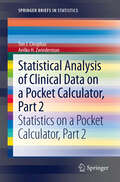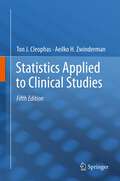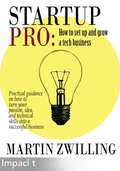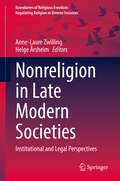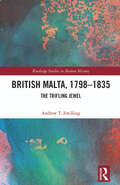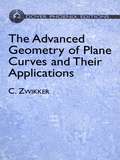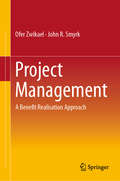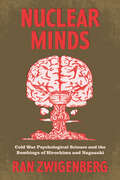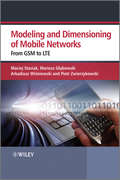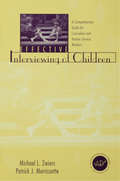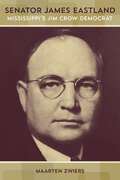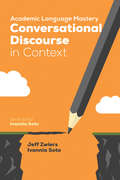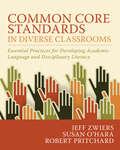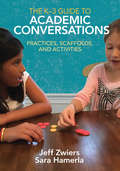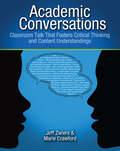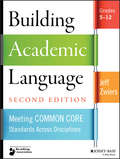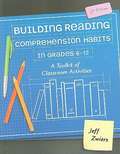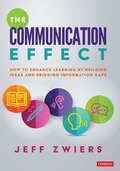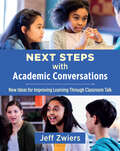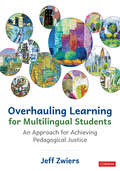- Table View
- List View
Statistical Analysis of Clinical Data on a Pocket Calculator, Part 2
by Aeilko H. Zwinderman Ton J. CleophasThe first part of this title contained all statistical tests relevant to starting clinical investigations, and included tests for continuous and binary data, power, sample size, multiple testing, variability, confounding, interaction, and reliability. The current part 2 of this title reviews methods for handling missing data, manipulated data, multiple confounders, predictions beyond observation, uncertainty of diagnostic tests, and the problems of outliers. Also robust tests, non-linear modeling , goodness of fit testing, Bhatacharya models, item response modeling, superiority testing, variability testing, binary partitioning for CART (classification and regression tree) methods, meta-analysis, and simple tests for incident analysis and unexpected observations at the workplace and reviewed. Each test method is reported together with (1) a data example from practice, (2) all steps to be taken using a scientific pocket calculator, and (3) the main results and their interpretation. Although several of the described methods can also be carried out with the help of statistical software, the latter procedure will be considerably slower. Both part 1 and 2 of this title consist of a minimum of text and this will enhance the process of mastering the methods. Yet the authors recommend that for a better understanding of the test procedures the books be used together with the same authors' textbook "Statistics Applied to Clinical Studies" 5th edition edited 2012, by Springer Dordrecht Netherlands. More complex data files like data files with multiple treatment modalities or multiple predictor variables can not be analyzed with a pocket calculator. We recommend that the small books "SPSS for starters", Part 1 and 2 (Springer, Dordrecht, 2010, and 2012) from the same authors be used as a complementary help for the readers' benefit.
Statistics Applied to Clinical Studies
by Aeilko H. Zwinderman Ton J. CleophasThanks to the omnipresent computer, current statistics can include data files of many thousands of values, and can perform any exploratory analysis in less than seconds. This development, however fascinating, generally does not lead to simple results. We should not forget that clinical studies are, mostly, for confirming prior hypotheses based on sound arguments, and the simplest tests provide the best power and are adequate for such studies. In the past few years the authors of this 5th edition, as teachers and research supervisors in academic and top-clinical facilities, have been able to closely observe the latest developments in the field of clinical data analysis, and they have been able to assess their performance. In this 5th edition the 47 chapters of the previous edition have been maintained and upgraded according to the current state of the art, and 20 novel chapters have been added after strict selection of the most valuable and promising novel methods. The novel methods are explained using practical examples and step-by-step analyses readily accessible for non-mathematicians. All of the novel chapters have been internationally published by the authors in peer-reviewed journal, including the American Journal of Therapeutics, the European Journal of Clinical Investigation, The International journal of Clinical Pharmacology and therapeutics, and other journals, and permission is granted by all of them to use this material in the current book. We should add that the authors are well-qualified in their fields of knowledge. Professor Zwinderman is president-elect of the International Society of Biostatistics, and Professor Cleophas is past-president of the American College of Angiology. From their expertise they should be able to make adequate selections of modern methods for clinical data analysis for the benefit of physicians, students, and investigators. The authors, although from a different discipline, one clinician and one statistician, have been working and publishing together for over 10 years, and their research of statistical methodology can be characterized as a continued effort to demonstrate that statistics is not mathematics but rather a discipline at the interface of biology and mathematics. They firmly believe that any reader can benefit from this clinical approach to statistical data analysis.
StartupPro: How to set up and grow a tech business
by Martin ZwillingIf your find yourself daydreaming about your own business and not just your next promotion, this book will help you shape your ideas as you begin your enrepreneurial journey.
Nonreligion in Late Modern Societies: Institutional and Legal Perspectives (Boundaries of Religious Freedom: Regulating Religion in Diverse Societies)
by Anne-Laure Zwilling Helge ÅrsheimThis volume presents results from new and ongoing research efforts into the role of nonreligion in education, politics, law and society from a variety of different countries. Featuring data from a wide range of quantitative and qualitative studies, the book exposes the relational dynamics of religion and nonreligion. Firstly, it highlights the extent to which nonreligion is defined and understood by legal and institutional actors on the basis of religions, and often replicates the organisation of society and majority religions. At the same time, it displays how essential it is to approach nonreligion on its own, by freeing oneself from the frameworks from which religion is thought.The book addresses pressing questions such as: How can nonreligion be defined, and how can the “nones” be grasped and taken into account in studies on religion? How does the sociocultural and religious backdrop of different countries affect the regulation and representation of nonreligion in law and policymaking? Where and how do nonreligious individuals and collectives fit into institutions in contemporary societies? How does nonreligion affect notions of citizenship and national belonging? Despite growing scholarly interest in the increasing number of people without religion, the role of nonreligion in legal and institutional settings is still largely unexplored.This volume helps fill the gap, and will be of interest to students, researchers, policymakers and others seeking deeper understanding of the changing role of nonreligion in modern societies.
British Malta, 1798–1835: The Trifling Jewel (Routledge Studies in Modern History)
by Andrew T. ZwillingBritish Malta, 1798–1835 explores the incorporation and early administration of Malta as a British protectorate, and later as a Crown colony.Few connections existed between Great Britain and Malta before 1798, but Napoleon’s Mediterranean ambitions forged a link that remained even after the expulsion of the French. Malta’s incorporation into the British Empire encountered numerous and varied challenges: a deadly plague, diplomatic rows, economic rebuilding, continual food supply obstacles, and the unique challenge of governing a long-subjugated population. The Maltese people spent the previous 228 years ruled by an anachronistic crusading order that they were barred from joining. While most sought the protection of the British government, many also strove for more Maltese autonomy and agency. This tension helped define the first three and a half decades of British rule in Malta. Reaching beyond the traditional periodization of the Napoleonic era, this book provides a broader context of the fitful growth of the British Empire.Scholars and general readers drawn to the history of Malta, the British Mediterranean, and the expansion of the British Empire will find value in this narrative history.
The Advanced Geometry of Plane Curves and Their Applications (Dover Books on Mathematics)
by C. Zwikker"Of chief interest to mathematicians, but physicists and others will be fascinated ... and intrigued by the fruitful use of non-Cartesian methods. Students ... should find the book stimulating." -- British Journal of Applied PhysicsThis study of many important curves, their geometrical properties, and their applications features material not customarily treated in texts on synthetic or analytic Euclidean geometry. Its wide coverage, which includes both algebraic and transcendental curves, extends to unusual properties of familiar curves along with the nature of lesser known curves.Informative discussions of the line, circle, parabola, ellipse, and hyperbola presuppose only the most elementary facts. The less common curves -- cissoid, strophoid, spirals, the leminscate, cycloid, epicycloid, cardioid, and many others -- receive introductions that explain both their basic and advanced properties. Derived curves-the involute, evolute, pedal curve, envelope, and orthogonal trajectories-are also examined, with definitions of their important applications. These range through the fields of optics, electric circuit design, hydraulics, hydrodynamics, classical mechanics, electromagnetism, crystallography, gear design, road engineering, orbits of subatomic particles, and similar areas in physics and engineering. The author represents the points of the curves by complex numbers, rather than the real Cartesian coordinates, an approach that permits simple, direct, and elegant proofs.
Project Management: A Benefit Realisation Approach
by Ofer Zwikael John R. SmyrkThis book is a complete project management toolkit for project leaders in business, research and industry. <P><P> Projects are approved and financed to generate benefits. Project Management: A Benefit Realisation Approach proposes a complete framework that supports this objective – from project selection and definition, through execution, and beyond implementation of deliverables until benefits are secured. <P><P> The book is the first to explain the creation of organisational value by suggesting a complete, internally-consistent and theoretically rigorous benefit-focused project management methodology, supported with an analytical technique: benefit engineering. Benefit engineering offers a practical approach to the design and maintenance of an organisation’s project portfolio. <P><P> Building upon the authors’ earlier successful book, Project Management for the Creation of Organisational Value, this comprehensively revised and expanded new book contains the addition of new chapters on project realisation. The book offers a rigorous explanation of how benefits emerge from a project. This approach is developed and strengthened — resulting in a completely client-oriented view of a project. <P><P> Senior executives, practitioners, students and academics will find in this book a comprehensive guide to the conduct of projects, which includes robust models, a set of consistent principles, an integrated glossary, enabling tools, illustrative examples and case studies.
Hiroshima
by Ran ZwigenbergIn 1962, a Hiroshima peace delegation and an Auschwitz survivor's organization exchanged relics and testimonies, including the bones and ashes of Auschwitz victims. This symbolic encounter, in which the dead were literally conscripted in the service of the politics of the living, serves as a cornerstone of this volume, capturing how memory was utilized to rebuild and redefine a shattered world. This is a powerful study of the contentious history of remembrance and the commemoration of the atomic bomb in Hiroshima in the context of the global development of Holocaust and World War II memory. Emphasizing the importance of nuclear issues in the 1950s and 1960s, Zwigenberg traces the rise of global commemoration culture through the reconstruction of Hiroshima as a 'City of Bright Peace', memorials and museums, global tourism, developments in psychiatry, and the emergence of the figure of the survivor-witness and its consequences for global memory practices.
Nuclear Minds: Cold War Psychological Science and the Bombings of Hiroshima and Nagasaki
by Ran ZwigenbergHow researchers understood the atomic bomb’s effects on the human psyche before the recognition of Post-Traumatic Stress Disorder. In 1945, researchers on a mission to Hiroshima with the United States Strategic Bombing Survey canvassed survivors of the nuclear attack. This marked the beginning of global efforts—by psychiatrists, psychologists, and other social scientists—to tackle the complex ways in which human minds were affected by the advent of the nuclear age. A trans-Pacific research network emerged that produced massive amounts of data about the dropping of the bomb and subsequent nuclear tests in and around the Pacific rim. Ran Zwigenberg traces these efforts and the ways they were interpreted differently across communities of researchers and victims. He explores how the bomb’s psychological impact on survivors was understood before we had the concept of post-traumatic stress disorder. In fact, psychological and psychiatric research on Hiroshima and Nagasaki rarely referred to trauma or similar categories. Instead, institutional and political constraints—most notably the psychological sciences’ entanglement with Cold War science—led researchers to concentrate on short-term damage and somatic reactions or even, in some cases, on denial of victims’ suffering. As a result, very few doctors tried to ameliorate suffering. But, Zwigenberg argues, it was not only that doctors “failed” to issue the right diagnosis; the victims’ experiences also did not necessarily conform to our contemporary expectations. As he shows, the category of trauma should not be used uncritically in a non-Western context. Consequently, this book sets out, first, to understand the historical, cultural, and scientific constraints in which researchers and victims were acting and, second, to explore how suffering was understood in different cultural contexts before PTSD was a category of analysis.
Festivals of the World: Poland
by Aldona M. Zwierzynska-ColdicottExperience all the color and excitement of a Polish swieta in this intriguing volume. Learn about namedays, see the Passion Play in Kalwaria Zebrzydowska, then make a Palm Sunday palm and have your own swieta! This exciting series of informational books introduces young readers to the festivals and cultures of some of the most fascinating countries in the world. Each volume is written in a lively style accompanied by striking photographs that encourage further study of our worldwide neighborhood. Easy, step-by-step instructions for creating a craft and preparing a food item add to the fun and provide the basics for a do-it-yourself festival.
Modelling and Dimensioning of Mobile Wireless Networks
by Piotr Zwierzykowski Arkadiusz Wisniewski Mariusz Glabowski Maciej StasiakThis book is a must-read for all network planners and other professionals wishing to improve the quality and cost efficiency of 3G and LTE networksIn this book, the authors address the architecture of the 2/3G network and the Long Term Evolution (LTE) network. The book proposes analytical models that make the analysis and dimensioning of the most important interfaces, i.e. WCDMA or Iub, possible. Furthermore, the authors include descriptions of fundamental technological issues in 2/3 G networks, basic traffic engineering models and frequent examples of the application of analytical models in the analysis and dimensioning of the interface of cellular networks. The specific knowledge included in the content will enable the reader to understand and then to prepare appropriate programming softwares that will allow them to evaluate quality parameters of cellular networks, i.e. blocking probabilities or call losses. Additionally, the book presents models for the analysis and dimensioning of the Wideband Code Division Multiple Access (WCDMA) radio interface and the Iub interface, both carrying a mixture of Release 99 traffic (R99) and High-Speed Packet Access (HSPA) traffic streams. Finally, the analytical models presented in the book can be also used in the process of modeling and optimization of LTE networks.Key Features:Describes the architecture and the modes of operation of the cellular 2/3/4G systems and the LTE network Covers the traffic theory and engineering within the context of mobile networks Presents original analytical methods that enable their users to dimension selected interfaces of cellular networks Discusses models for the analysis and dimensioning of the Wideband Code Division Multiple Access (WCDMA) radio interface and the Iub interface, both carrying a mixture of Release 99 traffic (R99) and High-Speed Packet Access (HSPA) traffic streams Includes problems as well as an accompanying website containing solutions, software tools and interactive flash animations (http://wiley.teletraffic.pl) This book will be an invaluable guide for professional engineers (radio planning engineers, optimization engineers, transmission engineers, core network engineers, Service Management engineers) working in the areas of mobile wireless networks technology, not only in optimization process, but also in profitability assessment of newly implemented services (i.e. in NPV - Net Present Value analysis), and researchers and scientists. Advanced students in the fields of mobile communications networks and systems will also find this book insightful.
Effective Interviewing of Children: A Comprehensive Guide for Counselors and Human Service Workers
by Michael Zwiers Patrick J. MorrissetteFirst published in 1999. Routledge is an imprint of Taylor & Francis, an informa company.
Senator James Eastland: Mississippi's Jim Crow Democrat (Making the Modern South)
by Maarten ZwiersIn the years following World War II, the national Democratic Party aligned its agenda more and more with the goals of the civil rights movement. By contrast, a majority of southern Democrats remained as committed as ever to a traditional, segregationist ideology. Through the career of Senator James Eastland, one of the mid-century's most prominent politicians, author Maarten Zwiers explores the uneasy, yet mutually beneficial relationship between conservative southerners and the increasingly liberal party to which they belonged. Mississippi Democrat James "Big Jim" Eastland began an influential four-decade career in the United States Senate in 1941, ultimately rising to become president pro tempore of the Senate, a position that placed him third in the line of presidential succession. His reputation for toughness developed from his unfailing and ruthless opposition to greater civil rights and his concern over the global spread of communism, as he believed participants in the two movements were working together to undermine the American way of life. Zwiers contends that despite Eastland's extreme positions, he still managed to maintain influence through productive relationships with his Senate colleagues-liberal as well as conservative. Though the progressive wing of the Democratic Party continued to push for stronger civil rights legislation, they valued compromise with southern senators like Eastland in order to ensure support from a region the Democrats could ill afford to lose. While Eastland's campaigning rhetoric was inflammatory, his ability to operate within the national political structure by leveraging moderate concessions contributed to his lengthy and effective career. Drawing on recently opened archival records, Maarten Zwiers offers a nuanced portrait of a man frequently portrayed as a southern zealot. Senator James Eastland provides a case study of the complicated relationship between party and party members that allowed Democrats to maintain power in the South for much of the twentieth century.
Academic Language Mastery: Conversational Discourse in Context
by Jeff Zwiers Ivannia M. SotoBy now it’s a given: if we’re to help our ELLs and SELs access the rigorous demands of today’s content standards, we must cultivate the “code” that drives school success: academic language. Look no further for assistance than this much-anticipated series from Ivannia Soto, in which she invites field authorities Jeff Zwiers, David and Yvonne Freeman, Margarita Calderon, and Noma LeMoine to share every teacher’s need-to-know strategies on the four essential components of academic language. The subject of this volume is conversational discourse. Here, Jeff Zwiers reveals the power of academic conversation in helping students develop language, clarify concepts, comprehend complex texts, and fortify thinking and relational skills. With this book as your roadmap, you’ll learn how to: Foster the skills and language students must develop for productive interactions Implement strategies for scaffolding paired conversations Assess student’s oral language development as you go It’s imperative that our ELLs and SELs practice academic language in rich conversations with others in school, especially when our classrooms may be their only opportunities to receive modeling, scaffolding, and feedback focused on effective discourse. This book, in concert with the other three volumes in the series, can provide both a foundation and a framework for accelerating the learning of diverse students across grade levels and disciplines.
Academic Language Mastery: Conversational Discourse in Context
by Jeff Zwiers Ivannia M. SotoBy now it’s a given: if we’re to help our ELLs and SELs access the rigorous demands of today’s content standards, we must cultivate the “code” that drives school success: academic language. Look no further for assistance than this much-anticipated series from Ivannia Soto, in which she invites field authorities Jeff Zwiers, David and Yvonne Freeman, Margarita Calderon, and Noma LeMoine to share every teacher’s need-to-know strategies on the four essential components of academic language. The subject of this volume is conversational discourse. Here, Jeff Zwiers reveals the power of academic conversation in helping students develop language, clarify concepts, comprehend complex texts, and fortify thinking and relational skills. With this book as your roadmap, you’ll learn how to: Foster the skills and language students must develop for productive interactions Implement strategies for scaffolding paired conversations Assess student’s oral language development as you go It’s imperative that our ELLs and SELs practice academic language in rich conversations with others in school, especially when our classrooms may be their only opportunities to receive modeling, scaffolding, and feedback focused on effective discourse. This book, in concert with the other three volumes in the series, can provide both a foundation and a framework for accelerating the learning of diverse students across grade levels and disciplines.
Common Core Standards in Diverse Classrooms: Essential Practices for Developing Academic Language and Disciplinary Literacy
by Jeff Zwiers Susan O'Hara Robert PritchardThe Common Core State Standards require students to do more with knowledge and language than ever before. Rather than be mere consumers of knowledge, students must now become creators, critics, and communicators of ideas across disciplines. Yet in order to take on these new and exciting roles, many students need daily teaching with an extra emphasis on accelerating their academic communication skills. Common Core Standards in Diverse Classrooms: Essential Practices for Developing Academic Language and Disciplinary Literacy describes seven research-based teaching practices for developing complex language and literacy skills across grade levels and disciplines: using complex texts, fortifying complex output, fostering academic interaction, clarifying complex language, modeling, guiding, and designing instruction. Most important, you will find clear descriptions and examples of how these essential practices can-;and should-;be woven together in real lessons. The book: Clarifieshow to support the learning of complex language that students need for reaching Common Core and other standardsProvides practical ways to realize the instructional shifts needed with the implementation of new standards in diverse classroomsIncludes frameworks and descriptions on how to develop students' complex language, speaking, and writingHelps maximize strategies and tools for building system-wide capacity for sustained growth in the practicesCommon Core Standards in Diverse Classrooms is a concise guide for helping us improve our practices to strengthen two vital pillars that support student learning: academic language and disciplinary literacy.
The K-3 Guide to Academic Conversations: Practices, Scaffolds, and Activities
by Jeff Zwiers Sara R. Hamerla“For thousands of years people have been using the skills we describe in this book to engage in conversations with others. What isn’t as prevalent, however, is instruction--especially in primary grades—in which we engage students in productive conversations about academic ideas. This book fills that very big need.” --Jeff Zwiers & Sara Hamerla Talk about content mastery . . . Primary teachers, you won’t want to miss this: if you’re looking for a single resource to foster purposeful content discussions and high-quality interpersonal engagement, then put Jeff Zwiers and Sara Hamerla’s K-3 Guide to Academic Conversations at the top of your reading list. Whether your students love to talk or not, all must be equipped with key conversation skills such as active listening, taking turns, posing, clarifying, supporting with examples, and arguing ideas. This ready resource comes packed with every imaginable tool you could need to make academic conversations part of your everyday teaching: Sample lesson plans and anchor charts Guidelines for creating effective prompts Applications across content areas, with corresponding assessments Rubrics and protocols for listening to student speech Transcripts of conversations and questions for reflection Companion website with video and downloadable resources Tens of thousands of students in the upper grades have reaped the benefits of academic conversations: high-quality face-to-face interactions, increased motivation, stronger collaborative argumentation skills, and better understanding and retention of content. The K-3 Guide to Academic Conversations is that resource for providing your primary students with the same powerful learning opportunities.
The K-3 Guide to Academic Conversations: Practices, Scaffolds, and Activities
by Jeff Zwiers Sara R. Hamerla“For thousands of years people have been using the skills we describe in this book to engage in conversations with others. What isn’t as prevalent, however, is instruction--especially in primary grades—in which we engage students in productive conversations about academic ideas. This book fills that very big need.” --Jeff Zwiers & Sara Hamerla Talk about content mastery . . . Primary teachers, you won’t want to miss this: if you’re looking for a single resource to foster purposeful content discussions and high-quality interpersonal engagement, then put Jeff Zwiers and Sara Hamerla’s K-3 Guide to Academic Conversations at the top of your reading list. Whether your students love to talk or not, all must be equipped with key conversation skills such as active listening, taking turns, posing, clarifying, supporting with examples, and arguing ideas. This ready resource comes packed with every imaginable tool you could need to make academic conversations part of your everyday teaching: Sample lesson plans and anchor charts Guidelines for creating effective prompts Applications across content areas, with corresponding assessments Rubrics and protocols for listening to student speech Transcripts of conversations and questions for reflection Companion website with video and downloadable resources Tens of thousands of students in the upper grades have reaped the benefits of academic conversations: high-quality face-to-face interactions, increased motivation, stronger collaborative argumentation skills, and better understanding and retention of content. The K-3 Guide to Academic Conversations is that resource for providing your primary students with the same powerful learning opportunities.
Academic Conversations: Classroom Talk that Fosters Critical Thinking and Content Understandings
by Jeff Zwiers Marie CrawfordConversing with others has given insights to different perspectives, helped build ideas, and solve problems. Academic conversations push students to think and learn in lasting ways. Academic conversations are back-and-forth dialogues in which students focus on a topic and explore it by building, challenging, and negotiating relevant ideas. In Academic Conversations: Classroom Talk that Fosters Critical Thinking and Content Understandings authors Jeff Zwiers and Marie Crawford address the challenges teachers face when trying to bring thoughtful, respectful, and focused conversations into the classroom. They identify five core communications skills needed to help students hold productive academic conversation across content areas: Elaborating and Clarifying Supporting Ideas with Evidence Building On and/or Challenging Ideas Paraphrasing Synthesizing This book shows teachers how to weave the cultivation of academic conversation skills and conversations into current teaching approaches. More specifically, it describes how to use conversations to build the following: Academic vocabulary and grammar Critical thinking skills such as persuasion, interpretation, consideration of multiple perspectives, evaluation, and application Literacy skills such as questioning, predicting, connecting to prior knowledge, and summarizing An academic classroom environment brimming with respect for others' ideas, equity of voice, engagement, and mutual support The ideas in this book stem from many hours of classroom practice, research, and video analysis across grade levels and content areas. Readers will find numerous practical activities for working on each conversation skill, crafting conversation-worthy tasks, and using conversations to teach and assess. Academic Conversations offers an in-depth approach to helping students develop into the future parents, teachers, and leaders who will collaborate to build a better world.
Building Academic Language: Meeting Common Core Standards Across Disciplines, Grades 5-12
by Jeff Zwiers“Of the over one hundred new publications on the Common Core State Standards (CCSS), this one truly stands out! In the second edition of Building Academic Language, Jeff Zwiers presents a much-needed, comprehensive roadmap to cultivating academic language development across all disciplines, this time placing the rigor and challenges of the CCSS front and center. A must-have resource!” —Andrea Honigsfeld, EdD, Molloy College “Language is critical to the development of content learning as students delve more deeply into specific disciplines. When students possess strong academic language, they are better able to critically analyze and synthesize complex ideas and abstract concepts. In this second edition of Building Academic Language, Jeff Zwiers successfully builds the connections between the Common Core State Standards and academic language. This is the ‘go to’ resource for content teachers as they transition to the expectations for college and career readiness.” —Katherine S. McKnight, PhD, National Louis University With the adoption of the Common Core State Standards (CCSS) by most of the United States, students need help developing their understanding and use of language within the academic context. This is crucially important throughout middle school and high school, as the subjects discussed and concepts taught require a firm grasp of language in order to understand the greater complexity of the subject matter. Building Academic Language shows teachers what they can do to help their students grasp language principles and develop the language skills they’ll need to reach their highest levels of academic achievement. The Second Edition of Building Academic Language includes new strategies for addressing specific Common Core standards and also provides answers to the most important questions across various content areas, including: What is academic language and how does it differ by content area? How can language-building activities support content understanding for students? How can teachers assist students in using language more effectively, especially in the academic context? How can academic language usage be modeled routinely in the classroom? How can lesson planning and assessment support academic language development? An essential resource for teaching all students, this book explains what every teacher needs to know about language for supporting reading, writing, and academic learning.
Building Reading Comprehension Habits in Grades 6-12: A Toolkit of Classroom Activities (Second Edition)
by Jeff ZwiersThis second edition succinctly describes practical ideas, including more than 15 new activities, which have been working in a wide range of middle school and high school classrooms. The author has used the ideas, seen them used by others, and researched their effectiveness in a variety of settings.
The Communication Effect: How to Enhance Learning by Building Ideas and Bridging Information Gaps
by Jeff ZwiersThe &“communication effect&” is what happens when we saturate our classrooms with authentic communication, which occurs when students use language to build up ideas and do meaningful things. For starters, authentic communication deepens and increases language development, learning of content concepts and skills, rigor and engagement, empathy and understanding of others&’ perspectives, agency and ownership of core ideas across disciplines, and social and emotional skills for building strong relationships. And these are just the starters. With The Communication Effect, Dr. Jeff Zwiers challenges teachers in Grades 3 and up to focus less on breadth and more on depth by grounding instruction and assessment in authentic (rather than pseudo-) communication. This book provides: Ideas for cultivating classroom cultures in which authentic communication thrives Clear descriptions and examples of the three features of authentic communication: 1. building up key ideas (claims and concepts); 2. clarifying terms and supporting ideas; and 3. creating and filling information gaps Over 175 suggestions for using the three features of authentic communication to enhance twenty commonly used instructional activities across disciplines Additional examples of not-so-commonly-used activities that embody the three features Suggestions for improving four different types of teacher creativity needed to design effective lessons, activities, and assessments that maximize authentic communication Our students deserve to get the most out of each minute of each lesson. Authentic communication can help. As you read The Communication Effect and apply its ideas, you will see how much better equipped and inspired your students are to grow into the amazing and gifted people that they were meant to become.
The Communication Effect: How to Enhance Learning by Building Ideas and Bridging Information Gaps
by Jeff ZwiersThe &“communication effect&” is what happens when we saturate our classrooms with authentic communication, which occurs when students use language to build up ideas and do meaningful things. For starters, authentic communication deepens and increases language development, learning of content concepts and skills, rigor and engagement, empathy and understanding of others&’ perspectives, agency and ownership of core ideas across disciplines, and social and emotional skills for building strong relationships. And these are just the starters. With The Communication Effect, Dr. Jeff Zwiers challenges teachers in Grades 3 and up to focus less on breadth and more on depth by grounding instruction and assessment in authentic (rather than pseudo-) communication. This book provides: Ideas for cultivating classroom cultures in which authentic communication thrives Clear descriptions and examples of the three features of authentic communication: 1. building up key ideas (claims and concepts); 2. clarifying terms and supporting ideas; and 3. creating and filling information gaps Over 175 suggestions for using the three features of authentic communication to enhance twenty commonly used instructional activities across disciplines Additional examples of not-so-commonly-used activities that embody the three features Suggestions for improving four different types of teacher creativity needed to design effective lessons, activities, and assessments that maximize authentic communication Our students deserve to get the most out of each minute of each lesson. Authentic communication can help. As you read The Communication Effect and apply its ideas, you will see how much better equipped and inspired your students are to grow into the amazing and gifted people that they were meant to become.
Next Steps with Academic Conversations: New Ideas for Improving Learning Through Classroom Talk
by Jeff ZwiersDr. Jeff Zwiers, an educational researcher at Stanford University, has spent the last 15 years analyzing classroom conversations to see how they can be better used and improved in classroom settings. Teachers who have worked with him report significant growth in students&’ engagement, content learning, language, creativity, and sense of agency. Zweirs introduced his initial vision for classroom conversations Academic Conversations: Classroom Talk that Fosters Critical Thinking and Content Understanding. His follow-up book, Next Steps with Academic Conversations: New Ideas for Improving Learning Through Classroom Talk , expands the first book with updated classroom strategies and practices. In this new version, teachers will discover: How to introduce buildable ideas and teach students how to develop and support them Equitable classroom discussions and how diverse backgrounds conversing can benefit social skills and emotional intelligence Highlights of new research-based theories on classroom conversation Ways to develop students' confidence in conversation and how classroom skills can apply to real world interactions This resource is the product of his extensive research, co-teaching, and collaborating with a wide range of educators. It was written for busy teachers who want a practical guide for strengthening the quality and quantity of productive conversations in their lessons.
Overhauling Learning for Multilingual Students: An Approach for Achieving Pedagogical Justice
by Jeff ZwiersAdopt a strengths-based, justice-centered approach to teaching multilinguals Offering educators a path to pedagogical justice for multilingual learners, Overhauling Learning for Multilingual Students outlines a comprehensive alternative model for instruction and assessment. With an emphasis on engaging multilingual learners in authentic communication and promoting student agency and creativity, this book is an urgent call-to-action for educators at all levels to value and leverage the many assets that multilingual students bring to every classroom. The book outlines six dimensions of pedagogical justice and offers practical strategies to implement a learner-centered approach that will help all students thrive. Additional features include: An assets-based framework designed to help multilingual learners learn and grow Guidance for shifting instructional strategies away from remediation and test preparation toward an engaging, justice-centered approach Activities to to help students collaboratively build up unique and important ideas (claims and concepts) across disciplines Written by scholar, practitioner, and best-selling author, Jeff Zwiers, Overhauling Learning for Multilingual Students supports educators to de-think and rethink traditional one-size-fits-all approaches to teaching and assessing multilingual learners.
